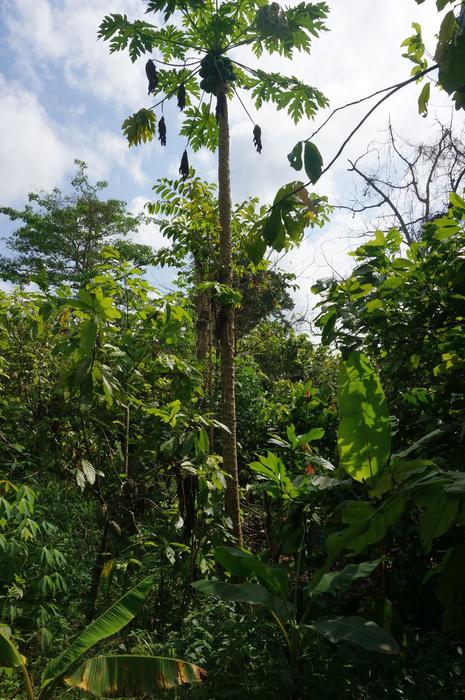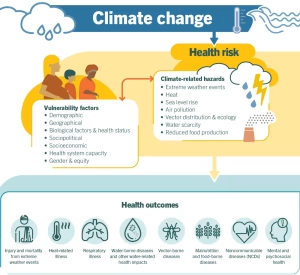At COP30 in Brazil, countries plan to armor themselves against a warming world – grist.org

Report on Climate Adaptation Finance and the Sustainable Development Goals
Introduction: A Strategic Pivot Towards Climate Adaptation
A recent call for a strategic shift in climate action, prioritizing adaptation over mitigation, has highlighted a critical imbalance in global efforts. This debate directly engages Sustainable Development Goal 13 (Climate Action), which urges urgent measures to combat climate change and its impacts. The focus is increasingly on preparing vulnerable populations for the unavoidable consequences of global warming, a core tenet of building climate resilience.
Funding Disparities and the Imperative for Global Partnership
The allocation of international climate finance reveals a significant gap that undermines global sustainability efforts. This disparity works against the principles of SDG 17 (Partnerships for the Goals), which calls for mobilizing financial resources to support developing countries.
- Mitigation Focus: 64% of international climate-related financing has been directed towards mitigation efforts, such as decarbonization.
- Adaptation Underfunding: Only 17% of financing has been allocated to adaptation, which includes building resilient infrastructure to protect communities from extreme weather events.
- Paris Agreement Mandate: The 2015 Paris Agreement promotes both mitigation and adaptation, yet funding has consistently favored the former, leaving the world’s poorest populations exposed and hindering progress on SDG 1 (No Poverty).
COP30 Negotiations: Addressing Climate Justice and Inequality
Negotiations at the 30th Conference of the Parties (COP30) aim to rectify the funding imbalance, which is a matter of both climate action and global equity. The discussions are central to achieving SDG 10 (Reduced Inequalities), as they address the disproportionate responsibility of wealthy nations for historical emissions and the heightened vulnerability of developing nations.
Key Negotiation Points
- A proposal to triple adaptation funding for vulnerable countries, from approximately $40 billion to $120 billion annually by 2030.
- Hesitancy from developed nations, including the European Union, to commit to specific financial targets despite acknowledging the need.
- Strong demands from developing countries for concrete, written financial commitments to translate goodwill into tangible support for adaptation projects.
Challenges to Mobilizing Adaptation Finance
Several geopolitical and economic factors challenge the mobilization of necessary funds, threatening the collaborative spirit required by SDG 17.
- United States’ Position: The absence of high-level U.S. officials and the nation’s second withdrawal from the Paris Agreement create a significant leadership and funding vacuum.
- Global Economic Pressures: Trade instability and ongoing conflicts have led many developed countries to reduce overall aid funding, further straining resources for climate adaptation.
- Scale of the Goal: Tripling the current adaptation finance, which stood at less than $33 billion in 2022, represents a substantial challenge in the current political climate.
Framework for Measuring Adaptation and Progress
A critical component of the COP30 negotiations involves establishing a clear framework for tracking the effectiveness of adaptation measures. This aligns with the accountability mechanisms inherent in the SDG framework.
Development of Adaptation Indicators
- Delegates are working to define up to 100 “adaptation indicators” to measure progress in terms of lives and dollars saved.
- These indicators must be universally relevant without imposing unreasonable financial or administrative burdens on nations.
- Examples of indicators directly support other SDGs, such as tracking the resilience of sanitation systems (SDG 6: Clean Water and Sanitation) or measuring stress on freshwater resources.
- Establishing a baseline with these indicators is considered essential for measuring progress and ensuring that financial flows lead to effective outcomes.
Conclusion: The Urgency of Financial Commitments for a Sustainable Future
The discussions at COP30 underscore that adaptation finance is not merely a line item in climate negotiations but a cornerstone of the 2030 Agenda for Sustainable Development. Without robust and predictable financial support, the framework for adaptation remains hollow. Achieving a specific, ambitious new spending target is critical to upholding the principles of global partnership (SDG 17), reducing inequality (SDG 10), and taking meaningful climate action (SDG 13) to protect the world’s most vulnerable communities.
Analysis of Sustainable Development Goals in the Article
1. Which SDGs are addressed or connected to the issues highlighted in the article?
The article addresses several Sustainable Development Goals (SDGs) through its discussion on climate change adaptation, international finance, and the disparity between developed and developing nations.
- SDG 13: Climate Action: This is the central theme of the article. It explicitly discusses the shift from climate mitigation to adaptation, the need to prepare for the consequences of global warming, and the international negotiations (COP30) aimed at coordinating responses to climate change.
- SDG 17: Partnerships for the Goals: The article focuses heavily on international cooperation and finance. It details the negotiations at COP30, the role of the European Union, the absence of the United States, and the collective responsibility of wealthy nations to provide financial support to developing countries for climate action. The entire discussion revolves around the global partnership needed to address climate change.
- SDG 1: No Poverty: The article repeatedly emphasizes the impact of climate change on the “world’s poorest” and “poorest nations.” The call for adaptation funding is framed as a way to help these vulnerable populations build resilience against climate-driven disasters, directly linking climate action to poverty reduction.
- SDG 10: Reduced Inequalities: The article highlights the inequality inherent in the climate crisis, stating that “the world’s richest countries are disproportionately responsible for causing climate change… while countries that did little to contribute to the crisis are least prepared to face it.” The call for financial transfers from developed to developing nations is a direct attempt to address this imbalance.
- SDG 9: Industry, Innovation and Infrastructure: The concept of adaptation is described as “building the infrastructure that will help especially the poorest nations weather supercharged fires, floods, and droughts.” This directly relates to the goal of developing resilient infrastructure. The article also mentions retrofitting sanitation systems as a specific example.
- SDG 6: Clean Water and Sanitation: A specific example of an adaptation indicator mentioned in the article is “Measuring the amount of stress bodies of water are under” and tracking the percentage of “sanitation systems that are retrofitted to conform to climate-resilient standards,” which directly connects the climate adaptation discussion to this SDG.
2. What specific targets under those SDGs can be identified based on the article’s content?
Several specific SDG targets are identifiable from the article’s focus on climate adaptation, finance, and infrastructure for developing nations.
- Target 13.1: Strengthen resilience and adaptive capacity to climate-related hazards and natural disasters in all countries.
- Explanation: The article’s core argument for a “strategic pivot” towards adaptation, described as “building the infrastructure that will help especially the poorest nations weather supercharged fires, floods, and droughts,” directly aligns with this target of strengthening resilience and adaptive capacity.
- Target 13.a: Implement the commitment undertaken by developed-country parties to the UNFCCC to a goal of mobilizing jointly $100 billion annually… to address the needs of developing countries.
- Explanation: The article extensively discusses the failure to adequately fund adaptation and the push at COP30 for new, larger financial commitments. It mentions a nascent plan to “triple adaptation funding… from the roughly $40 billion target now to $120 billion annually by 2030” and a broader goal of mobilizing “$1.3 trillion per year,” which are direct continuations and expansions of the principles in this target.
- Target 1.5: By 2030, build the resilience of the poor and those in vulnerable situations and reduce their exposure and vulnerability to climate-related extreme events.
- Explanation: The article explicitly states the goal is to help the “world’s poorest adapt to climate change” and armor “poorer countries… against climate-driven disaster.” This directly corresponds to the target of building the resilience of the poor against climate-related events.
- Target 17.3: Mobilize additional financial resources for developing countries from multiple sources.
- Explanation: The entire discussion about the need for wealthy nations to “cough up billions of dollars in additional funding” for poorer countries, and the debate around tripling adaptation funding at COP30, is a clear reflection of this target.
- Target 9.a: Facilitate sustainable and resilient infrastructure development in developing countries through enhanced financial, technological and technical support.
- Explanation: The article defines adaptation as “building the infrastructure” and mentions specific examples like retrofitting sanitation systems. The call for increased funding from developed nations to make this happen is a direct call for the enhanced financial support mentioned in this target.
3. Are there any indicators mentioned or implied in the article that can be used to measure progress towards the identified targets?
Yes, the article explicitly mentions the debate around defining “adaptation indicators” and provides several examples, both quantitative and qualitative, that can be used to measure progress.
- Financial Flow Indicators: The article provides several financial metrics that serve as direct indicators of progress on climate finance targets (like 13.a and 17.3).
- Total amount of adaptation funding provided to developing countries (e.g., the proposed target of $120 billion annually).
- The ratio of funding for mitigation versus adaptation (the article cites the current split as 64% vs 17%).
- Total climate finance mobilized for developing countries (e.g., the new floor of $300 billion per year by 2035 and the broader target of $1.3 trillion per year).
- Specific Adaptation Indicators: The article explicitly states that “Delegates also need to define up to 100 ‘adaptation indicators'” and gives concrete examples being debated.
- “Measuring the amount of stress bodies of water are under.” This indicator would measure resilience in water resource management (SDG 6).
- “Tracking the percentage of a given country’s sanitation systems that are retrofitted to conform to climate-resilient standards.” This indicator measures progress in building resilient infrastructure (SDG 9, SDG 6).
- Impact-Based Indicators: The article mentions that the effectiveness of adaptation measures is tracked in terms of outcomes.
- “Lives and dollars saved.” This is a crucial indicator for measuring the success of adaptation projects in strengthening resilience and reducing vulnerability (Target 1.5, 13.1).
4. Summary of SDGs, Targets, and Indicators
| SDGs | Targets | Indicators |
|---|---|---|
| SDG 1: No Poverty | 1.5: Build the resilience of the poor and reduce their vulnerability to climate-related extreme events. |
|
| SDG 6: Clean Water and Sanitation | (Implied) Build climate-resilient water and sanitation systems. |
|
| SDG 9: Industry, Innovation and Infrastructure | 9.a: Facilitate sustainable and resilient infrastructure development in developing countries through enhanced financial support. |
|
| SDG 13: Climate Action |
13.1: Strengthen resilience and adaptive capacity to climate-related hazards.
13.a: Implement the commitment by developed countries to mobilize climate finance for developing countries. |
|
| SDG 17: Partnerships for the Goals | 17.3: Mobilize additional financial resources for developing countries from multiple sources. |
|
Source: grist.org
What is Your Reaction?
 Like
0
Like
0
 Dislike
0
Dislike
0
 Love
0
Love
0
 Funny
0
Funny
0
 Angry
0
Angry
0
 Sad
0
Sad
0
 Wow
0
Wow
0














































.jpg.webp?itok=0ZsAnae9#)







:focal(1500,1000)/https://media.globalcitizen.org/a6/9a/a69a4720-d8a1-4715-b596-18738d03c05c/rotary_polio_hero_image.jpg?#)

/countries/sri-lanka/photo-credit---dmc-sri-lanka.tmb-1200v.jpg?sfvrsn=dc298bcc_1#)


















